Viola nephrophylla Greene
Common names:
Northern Bog Violet
Synonyms:
Viola nephrophylla Greene, Pittonia 3: 144. 1896. Type: U.S.A. Colorado. Cimarron River, 29 Aug 1896, E. L. Greene s.n. (lectotype (incorrectly designated as holotype by Landon McKinney, Sida, Bot. Misc. 7: 34. 1992; designation to lectotype corrected by Ballard et al. 2020. Journal of the Botanical Research Institute of Texas 14(2): 224): NDG34250 (n.v.); isolectotype: NDG34249 (n.v.); internet images).
Viola nephrophylla Greene var. cognata (Greene) C.L.Hitchc., Vasc. Pl. Pacific NorthW. 3: 445. 1961; Viola cognata Greene, Pittonia 3: 145. 1896
Viola nephrophylla Greene f. bicolor B.Boivin, Naturaliste Canad. 87: 49. 1960
Viola vagula Greene, Pittonia 4: 67. 1899
Viola galacifolia Greene, Pittonia 5: 30. 1902
Viola nephrophylla Greene var. arizonica (Greene) Kearney & Peebles, J. Washington Acad. Sci. 29(11): 487. 1939; Viola arizonica Greene, Pittonia 5: 33. 1902
Viola austinae Greene, Pittonia 5: 30. 1902
Viola eucycla Greene [replacement name for V. cyclophylla], Pittonia 5: 88. 1902; Viola cyclophylla Greene, Pittonia 4: 7. 1899 [illegitimate homonym of V. cyclophylla Gandoger (1875)]
Viola peramoena Greene, Pittonia 5: 94. 1902
Viola subjuncta Greene, Pittonia 5: 31. 1902
Viola subrotunda Greene, Pittonia 5: 118. 1903
Viola lunellii Greene, Leafl. bot. observ. 2(2): 95. 1910-1912
Viola nephrophylla Greene f. albinea Farw., Amer. Midl. Naturalist 11: 64. 1928
Viola mccabeiana M.S.Baker, Madroño 5: 226, pl. 22, fig. 5, pl. 23. 1940
Viola cucullata Elliott var. glaberrima Ging., in DC., Prodr. 1: 292. 1824
Description:
Acaulescent rosulate perennials from thick rhizome, ≤ 16 cm tall; foliage and peduncles green, lower surface of leaf blades commonly purple tinged, glabrous or upper surface of leaf blades with minute scattered subappressed hairs; stipules free, irregularly glandular-fimbriate; leaves spreading, leaf blades undivided, largest ≤ 52 × 49 mm, ovate to broadly ovate (infrequently narrowly ovate or ovate-triangular), broadening in fruit to deltate-ovate or reniform, base cordate, margins crenate to crenate-serrate, eciliate, apex obtuse to broadly rounded (uncommonly acute); chasmogamous peduncle held above the leaves early in fl, often surpassed by the leaves later; chasmogamous flower ≤ 18 mm; calyx glabrous, eciliate; lowest sepals oblong-lanceolate to ovate-lanceolate, obtuse to rounded; auricles short and entire, not elongating in fruit; corolla blue to purple, throat white; spur short-globose; lateral petals densely bearded with filiform hairs, spurred petal densely bearded; cleistogamous flowers produced after chasmogamous, on declined or ascending peduncle shorter than petioles; capsule 7–10 mm, green drying to tan, unspotted, glabrous; seeds 1.3–1.9 × 0.7–1.2 mm, medium brown to dark olive-brown, unspotted or rarely with minute raised darker spots; 2n=54.
Similar species:
This species has undivided broadly ovate or orbicular to reniform blades with broadly obtuse (rarely broadly acute) to rounded apex and crenate margins that do not appear to broaden much in fruit, the foliage glabrous except for small scattered subappressed hairs on the upper surface of the blades. As such it could be confused with a diversity of other Borealiamericanae taxa with somewhat similar foliage at any time during the growing season, including Viola communis, V. latiuscula, V. pratincola, V. retusa, V. sororia [glabrous variant] and V. sororia [hirsutuloides variant]. In chasmogamous flower it differs from
V. communis, V. sororia [glabrous variant] and V. sororia [hirsutuloides variant] in its typically densely bearded spurred petal, and additionally from V. communis in its obtuse to rounded sepals and short rounded auricles; and from V. latiuscula, V. pratincola and V. retusa by its rounded sepals, and further from the latter two in its short rounded auricles. In cleistogamous fruit it can be separated from Viola communis, V. pratincola and V. retusa by its short declined or ascending peduncle and brown usually unspotted seeds; and from V. sororia [glabrous variant] and V. sororia [hirsutuloides variant] by its unspotted capsule and brown unspotted seeds.Ecology:
Strongly calciphilic, seasonally or perennially saturated open sites such as bedrock pavement, rocky shores, fens and wet prairies, occasionally in disturbed sites especially around crushed limestone.
Distribution:
Transcontinental, NL and NU to YT, south to MA, sporadic southward along the Appalachian Mountains to se. WV and w. VA, south to w. OH, IN, IL, LA, TX, and CA.
Rarity:
State listed in CT, NH, NY, OH, and WV.
Phenology:
Chasmogamous flower April–June (October–November), chasmogamous fruit May–July, cleistogamous fruit June–September.
Affinities:
This species belongs to the Acaulescent Blue Violet lineage, sect. Nosphinium W.Becker, subsect. Boreali-Americanae (W.Becker) Gil-ad, in the Cucullata species group.
Hybrids:
Hybridizes with V. affinis (Brainerd 1906b, 1924, House 1924, Haines et al. 2011), V. communis [or possibly V. "sororia glabrous" or V. "sororia hirsutula-like"] (Brainerd 1924), V. cucullata (Brainerd 1906b, 1924, House 1924, Haines et al. 2011), V. pedatifida (Brainerd 1913a, Brainerd 1924), V. sagittata (Gaiser and Moore 1966), and V. sororia sensu stricto (Brainerd 1924, Haines et al. 2011). Brainerd reported that these exhibit intermediate or recombinant characteristics of foliage, chasmogamous flowers, cleistogamous capsules and seeds (where these did not abort). He noted that hybrids failed to reproduce by chasmogamous flowers and in cleistogamous reproduction were sterile or produced only a few viable seeds.
Comments:
Greene cited a single collection in the protologue but made no mention that this constituted a single sheet, and he cited no herbarium. The two sheets cited above at NDG have the same label data and match the protologue, but neither has an indication by Greene as to type status. McKinney (1992) apparently arbitrarily designated NDG34250 as the holotype and NDG34249 as an isotype, and Gil-ad (1995, 1997) later concurred. However, nothing distinguishes the two identical sheets, effectively rendering them syntypes. Ballard et al. (2020) corrected McKinney’s initial holotype designation to lectotype.
Brainerd (1921b), Brainerd Baird (1942), Fernald (1950), Alexander (1963), Russell (1965), Scoggan (1978), Strausbaugh and Core (1978), Swink and Wilhelm (1979), Gleason and Cronquist (1991), Ballard (1995, 2013), Haines et al. (2011), and Voss and Reznicek (2012) recognized this distinctive taxon as a species; Ballard (2013) included V. pratincola as a synonym of V. nephrophylla, while others referred V. pratincola to a broadly delineated glabrous to glabrate V. papilionacea Pursh or synonymized it under V. sororia Willd. McKinney (1992) and McKinney and Russell (2002) subsumed V. nephrophylla under V. sororia var. sororia, while Little and McKinney later reinstated the present taxon at species rank. Gil-ad (1995, 1997) found evidence of potential hybridization with another unknown species in macromorphological traits and micromorphological features of seeds of certain lectotype plants, but he tentatively accepted the name (and taxon) because other plants on the lectotype sheet expressed no such indications. This transcontinental species is surprisingly uniform in morphology over its broad range, distinct in its broadly ovate to reniform essentially glabrous leaf blades with common purple tinge on the lower surface, crenate blade margins, eciliate calyx, lowest sepals broad and obtuse to rounded, typically densely bearded spurred petal, green unspotted cleistogamous capsule on a declined peduncle, and brown to dark olive-brown seeds. The flowers are typically held above the small leaves during chasmogamous flower. This species is a very pronounced calciphile. Although quite rare in further north, its presence in the central Appalachian Mountains is confirmed by a number of West Virginia specimens at WVU and plants from three locations in Virginia. The latter are represented by scattered plants at Mountain Lake Biological Station in Giles Co., Virginia, growing around the crushed limestone roadways and paths, to which they were apparently introduced from a local limestone quarry with the crushed limestone; a cleistogamous fruiting plant collected by Johnny Townsend from the spring feeding a pristine fen near Blacksburg; and a herbarium sheet of specimens from a “swamp near Shenandoah Acres” in Augusta Co. (1 May 1965, A. M. Harvill 11958, FARM-0037915). Strausbaugh and Core cited specimens identified as the present species by Norman Russell from three northeastern counties of West Virginia, adjacent to Pennsylvania and Virginia; the species should be sought in strongly calcareous marl fens and sites with moist exposed limestone in the central and southern Appalachians. The overlooked but widespread Western Blue Violet, V. retusa Greene, is a Great Plains endemic recognized in this treatment as a distinct evolutionary species. It is misidentified as, and often synonymized under, V. nephrophylla. Greene described several segregate species (see synonyms) from midwestern and western populations of this violet, most of which do not differ in any appreciable feature from V. nephrophylla. Brainerd Baird (1942) tentatively accepted V. arizonica Greene and V. cognata Greene but noted that they may be minor “genetic variants”. However, plants reported with substantially pubescent foliage, often referred to V. arizonica Greene (which was described as having glabrous foliage, and the type of which is typical V. nephrophylla), require closer scrutiny.
Literature Cited:
Alexander, E. J. 1963. Violaceae. In Gleason, H. A., The new Britton and Brown illustrated flora of the northeastern United States and adjacent Canada. Hafner Publishing Co., Inc., New York, NY. 552-567.
Ballard Jr., H. E. 1995 ["1994"]. Violets of Michigan. Michigan Botanist 33: 131-199.
Ballard Jr., H. E. 2013. Violaceae. In Yatskievych, G., Flora of Missouri. Missouri Botanical Garden Press, St. Louis, MO. 1218-1243.
Brainerd, E. 1906b. Hybridism in the genus Viola,-II. Rhodora 8: 6-10.
Brainerd, E. 1913a. Four hybrids of Viola pedatifida. Bulletin of the Torrey Botanical Club 40: 249-260.
Brainerd, E. 1921b. Violets of North America. Vermont Agricultural Experiment Station Bulletin 224: 1-172.
Brainerd, E. 1924. The natural violet hybrids of North America. Vermont Agricultural Experiment Station Bulletin 239: 1-205.
Brainerd Baird, V. 1942. Wild violets of North America. University of California Press, Berkeley, CA.
Fernald, M. L. 1950. Violaceae. In Gray’s Manual of Botany, 8th ed. American Book Company, New York, NY. 1022-1042.
Gaiser, L. O., and R. J. Moore. 1966. A survey of the vascular plants of Lambton County, Ontario. Plant Res. Inst. Can. Dept. Agric. Ottawa, Ont. 122 pp.
Gil-ad, N. L. 1995. Systematics and evolution of Viola L. subsection Boreali-Americanae (W. Becker) Brizicky. Ph.D. dissertation. University of Michigan, Ann Arbor, MI.
Gil-ad, N. L. 1997. Systematics of Viola subsection Boreali-Americanae. Boissiera 53: 1-130.
Gil-ad, N. L. 1998. The micromorphologies of seed coats and petal trichomes of the taxa of Viola subsect. Boreali-Americanae (Violaceae) and their utility in discerning orthospecies from hybrids. Brittonia 50: 91-121.
Gleason, H. A., and A. Cronquist. 1991. Violaceae. In Manual of vascular plants of northeastern United States and adjacent Canada, 2nd ed. New York Botanical Garden, Bronx, NY. 157-163.
Haines, A., E. Farnsworth, and G. Morrison. 2011. Violaceae. In Flora Novae Angliae. Yale University Press, New Haven, CT. 873-886.
House, H. D. 1924. Annotated list of the ferns and flowering plants of New York state. Family 83 Violaceae. New York State Museum Bulletin 254: 499-512.
Little, R. J., and L. E. McKinney. 2015. Violaceae. In Flora of North America: Cucurbitaceae to Droseraceae, 106. Oxford University Press, New York, NY.
McKinney, L. E. 1992. A taxonomic revision of the acaulescent blue violets (Viola) of North America. Sida, Botanical Miscellany 7: 1-60.
McKinney, L. E., and N. H. Russell. 2002. Violaceae of the southeastern United States. Castanea 67: 369-379.
Russell, N. H. 1965. Violets (Viola) of the central and eastern United States: An introductory survey. Sida 2: 1-113.
Scoggan, H. J. 1978. Violaceae. In Flora of Canada, Part 3–Dicotyledoneae (Saururaceae to Violaceae). National Museums of Canada. Ottawa, Canada. 1103-1115.
Strausbaugh, P. D., and E. L. Core. 1978. Violaceae. In Flora of West Virginia, 2nd ed. Seneca Books, Inc., Morgantown, WV. 644-658.
Swink, F., and G. Wilhelm. 1979. Violaceae. In Plants of the Chicago region, 2nd ed. revised and expanded. Morton Arboretum, Lisle, IL. 384, 801-810.
Voss, E. G., and A. A. Reznicek. 2012. Violaceae. In Field manual of Michigan flora. The University of Michigan Press, Ann Arbor, MI. 913-922.
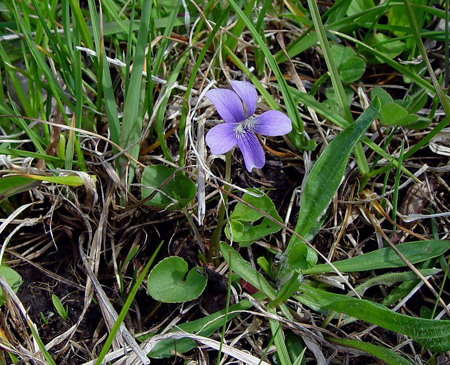
Chasmogamous flowering habit by Arthur Haines, Native Plant Trust

Chasmogamous flowering habit by Andrew Gibson, "Buckeye Botanist" website

Leaves by Arthur Haines, Native Plant Trust

Chasmogamous flower front view by Andrew Gibson, "Buckeye Botanist" website
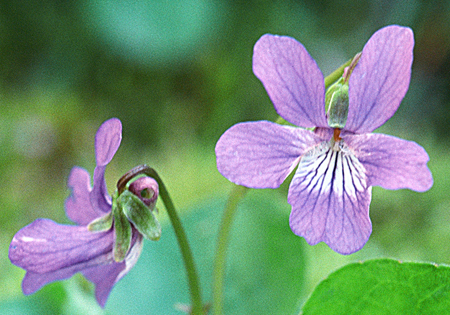
Chasmogamous flower front view by Kim Blaxland, "Botanikim" website (permission granted by Chris Blaxland)
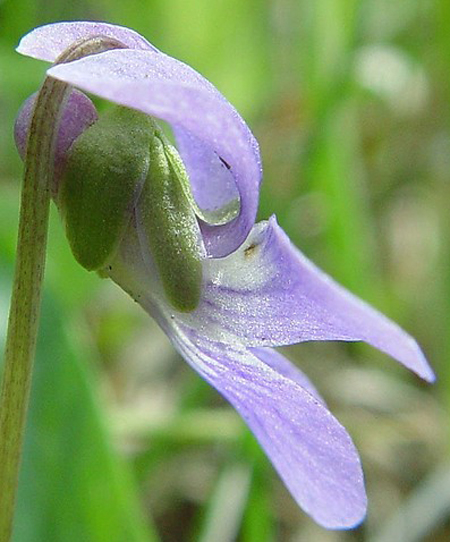
Chasmogamous flower profile view by Arthur Haines, Native Plant Trust
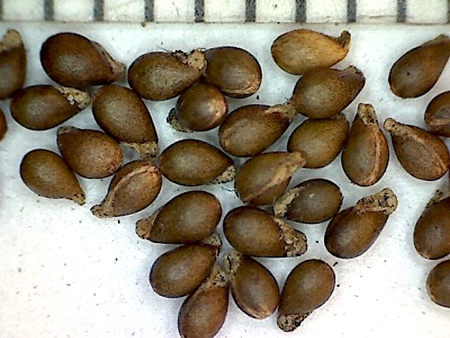
Seeds from herbarium specimen: ND, Butte, 8 Sep 1910, J. Lunell s.n. (NY)
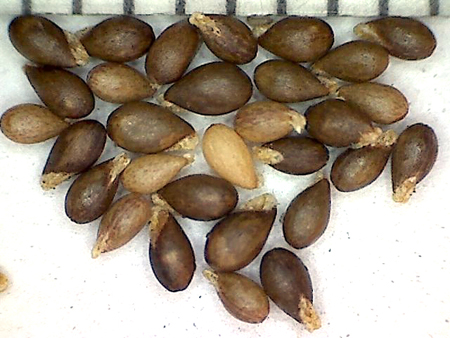
Seeds from herbarium specimen: Quebec, Bonaventure Co., Gravelly strand of Matapedia River Gorge, 30 Aug 1924, K. M. Wiegand & M. C. Wiegand 225 (NY)

Map by the Biota of North America Program